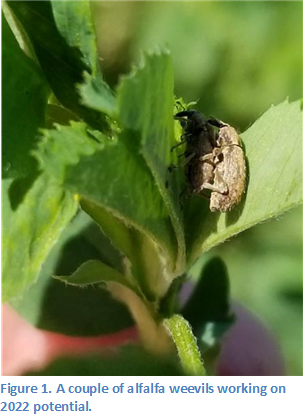Volume 25 Issue 6 | May 19, 2022
This newsletter and the advice herein are free. You usually get what you pay for.
Crop Weather
Rainfall, air and soil temperatures, degree-days, soil moistures, and other current and historical weather data for the University of Minnesota Southwest Research and Outreach Center (SWROC), a little spot about two miles west of Lamberton, MN, can be found at http://swroc.cfans.umn.edu/weather.
Crop Progress
Early planted corn and soybeans have started to emerge. Start evaluating stands once corn and soybeans can be rowed. This spring’s rainfall and planting progress has been variable across southern MN. Some areas are wrapping up while others have corn left to plant with bean planting progressing even slower.
Planting delays have created a wide range of spring tillage and planting dates for corn and soybeans in areas. This will have an impact on this season’s pest populations.
-
Look for early-season soybean aphids and bean leaf beetles in the earliest emerging soybeans. This includes any volunteers that did not emerge last fall.
-
1st generation multivoltine European corn borer moths will seek out the tallest cornfields.
-
Corn rootworm beetles, particularly northern corn rootworms, will be attracted to early silking fields. As the season progresses, late silking fields attract beetles.
-
Black cutworm flights have been relatively light this spring. Significant flights occurred from April 29 to May 1, mostly in the SW part of Minnesota. Moths were most likely to lay eggs in fields that were not tilled by that time, particularly where weed pressure is heavy (https://swroc.cfans.umn.edu/research/ipm/bcw-network).
-
Fields with manure or green manure (e. g., rye cover) incorporated the past week in southern MN, were attractive to egg-laying seedcorn maggot flies. https://vegedge.umn.edu/degree-days-midwest-insects/seed-corn-maggot
Small grains
We are starting to find English grain aphids in cereal rye. The presence of small nymphs indicates the first migrating aphids have been here for a bit. Populations are low.
Alfalfa
Don’t act too early on alfalfa weevils
It has been a long, tough planting season for many of us.
That vigorously growing alfalfa crop just might harbor alfalfa weevils, some tempting pest targets for a stress-relieving, preemptive insecticide strike.

Insecticide applications targeted to economically threatening insect populations have a good chance for ROI with reduced economic or biological risks.
On the other hand, spraying sub-economic alfalfa weevil populations, or spraying too early can lead to biological and economic problems.
Spraying early can miss late-arriving adults and unhatched eggs, increasing the need for an additional insecticide application, possibly more, if populations of other pests such as pea aphids are flared. Perceived insecticide resistance is often just a poorly applied or timed application. However, over time, insecticide applications select resistant insects in the population. Avoid applying the same insecticide back-to-back. In other words, an unneeded insecticide application limits your options for the next application.
Economic thresholds are based on the presence of alfalfa weevil larvae. Anthony Hanson put together a Crop News article on this insect and its thresholds at https://blog-crop-news.extension.umn.edu/2022/05/preparing-for-alfalfa-weevil-in-2022.html?m=1
It is shaping up to be a good year for alfalfa weevils in some Minnesota alfalfa fields. Overwintered alfalfa weevils continue to move into SW Minnesota alfalfa. Mating pairs and minor leaf feeding by the adults were observed at the UMN Southwest Research and Outreach Center on May 16. However, no larvae were observed. Start scouting if you already haven’t. Typically, most alfalfa weevil pressure and management decisions are late 1st cutting and early 2nd cutting.
It’s still too early to make alfalfa weevil treatment decisions, in most, if not all, fields. If you want to panic over alfalfa weevils, please wait until you know you have a field with a problem. You won’t have long to wait.
Corn
Small black cutworm larvae should be starting to make their presence known by leaf-feeding on corn and weeds. Do not let emerged weeds persist too long in corn. The chronic wet fields and wind are not helping. We will need some better weather to get post-emerge herbicides on.
Soybeans
There are getting to be some very large lambsquarters in some unplanted fields. These may not all be removed by pre-plant tillage. Fortunately, we have not seen hot dry weather to toughen them as herbicides have a harder time on large weeds.
Happy trails,
Bruce
